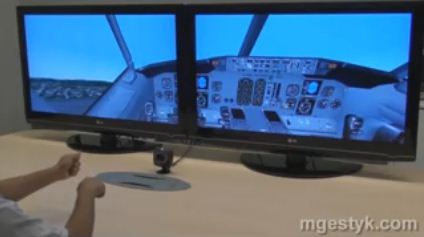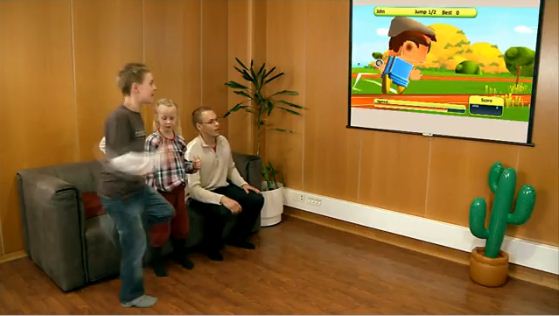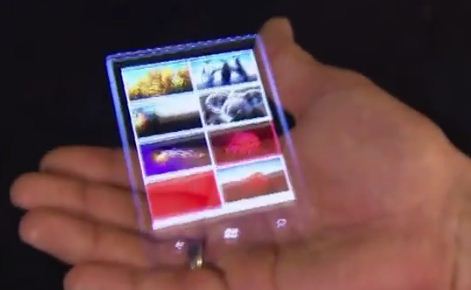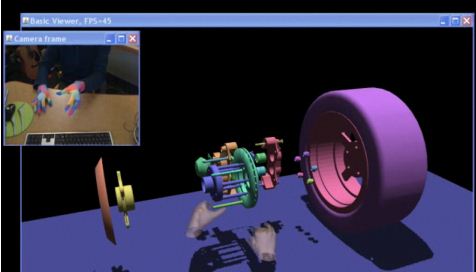New computer interfaces
Desktops currently have a WIMP interface. But the motive showed that other concepts are possible. New interfaces are changing the way computers are used, a revolution has already begun.
Concepts
Windows, MacOS, Gnome is a WIMP interface: Windows Icons + Menus + Pointers (mice or arrows).
This concept is opposed by others:
- NUI: Natural user interface.
The natural user interface is gesture, it is with the hands that objects are designated and moved. - OCGM: Objects, containers, gestures, manipulations.
From this new point of view, containers are no longer windows, but objects that may contain other objects. User gestures are recognized by various computer devices. All manipulation is the influence of the user on objects.
The latter concept should be the basis of Windows 8. It promises radical change. But while there are different techniques that are already suitable for use.
TrueMotion
TrueMotion turns PC into WII, and even technologically goes further...
The WII console, whose commercial success is enormous, made us take the first step in virtual reality. In order to create an equivalent technology for a PC, Siksene has developed the same pen, which is even more advanced.
Nintendo's Wiimote knows which way you're pointing your hand. The TrueMotion pen, thanks to a dock that creates an electro-magnetic field, is much more accurate because it knows what you are pointing at and also at what angle you are holding it!
TrueMotion is supposed to work with current PC games according to Sixense, and even better with games designed to take full advantage of its capabilities...
The prototype was presented at CES (Consumer Electronics Show) and will lead to a commercial product priced at around €100, with the game included.
Mgestyk
Mgestyk is a futuristic alternative to a mouse that already works: order a computer with gestures!
The site can't remember the movie "Minority Report," where we see Tom Cruise acting on screen, moving his arms...
To achieve this result, you need a camera and software from Mgestyk that will connect to it and that can interpret your movements.
There are many applications, as the series of videos presented on the site shows: a simulation of driving a car or flying, a selection of photos in the gallery, web navigation, Google Earth and all kinds of games.
This system makes us think of Nintendo's Wiimote or Logitech's 3D mouse with the advantage that we have empty hands... Watch the video:

Blob
Invented by the Finnish company Ball-It, blobo is a ball that allows you to control a character on the screen.
You can run, aim, move while holding the ball in your hand, movements will be transmitted to the computer via Bluetooth communication, which brings the avatar to life in the virtual world of the game.
Video

Kinect
Originally intended for the Xbox 360, Microsoft's Kinect is closer to virtual reality than Nintendo's Wii: it's with your whole body that you interact with the console.
No mouse, no pen, just sit next to the device to merge with the character on the screen, it plays all your movements...
See the full article on Kinect.
Virtual touch interface
In the continuation of Kinect with a spotlight, you can make any touch surface.
This technology was developed by Microsoft in conjunction with Carnegie Mellon University.
What applications? You can show the keyboard on the desktop or wall, icons on the object and, therefore, provide it with a virtual interface. There is no limit to what can be invented with this technology.
This can be combined with virtual reality and, thus, in addition to giving a new look to objects in the environment using images, make them additionally mutual, giving functions to virtually represented things!

Golodesk and NEI
The natural user interface (NUI) allows you to control objects directly in three-dimensional holographic space.
For example, you can insert your hand into the space with the image of the office and its accessory, hold a sheet of paper, transfer it to the table.
Microsoft has developed a system that applies this principle - Golodesk .
Click an image to view the video.
Text 2.0
The name Text 2.0 was given to an interface technology for the electronic reader that tracks the reader's gaze and adapts the image to highlight what they are looking at and what only.
Using a webcam and image recognition software, the system developed by Tobii Technology (and allegedly bought out by Apple) converts text using JavaScript and CSS to adapt it to what the reader wants to see.
MIT colored gloves
The idea behind MIT is to paint parts of the hand on a glove, which allows the camera to detect movements much more easily.
They are accurately reproduced on the screen by the gesture recognition program. The video below is compelling...
Areas
This is an interactive table or array, with a computer and cameras that interpret the user's gestures and display content depending on this.
Sony's version, attracTable goes even further. It can recognize the age, gender and facial expressions of the user, for example, joy or disappointment, and react depending on these parameters.
The desk features two cameras connected to a computer that controls a cursor or avatar. They put things there. If we put a motive there, it can serve as a giant screen for her.
- Demo video. It is expected to go on sale in June 2010.
AirSwing
The interface developed by Toshiba is another user interface for gesture recognition, consisting of a webcam and software. It uses little processor, about 3%.
The principle is to superimpose a translucent image of the user on the screen, which helps him better interact with content.
Mimesign, no touch interaction
Gesture control without touching the screen is a technology proposed by Elliptic Labs. A Norwegian ultrasound company uses a set of pre-programmed gestures to control the device.
Being human
Microsoft Research Cambridge challenged researchers to write a report on what the human-computer interface of the future could be, given the emerging technological innovations.
The report provides primarily for the evolution of the computers themselves, which, becoming smarter, are able to learn, will be able to partially find out what is expected of them, and will react without waiting for commands.
The interface will evolve from a GUI (Graphical User Interface), a graphical user interface such as Windows, KDE, Gnome, to something that will respond to speech, gestures, gaze, and even consider interaction through thought, which is technically possible today.
In addition, GPS, cameras, RFID (Low-cost Radio Frequency Identification) radio waves will be introduced into the interaction, which will create a global interaction between a person, computer, personal or work environment.
All this is planned for 2020.
See also
- Manual dexterity. By combining a stylus and gesture recognition, you get an unreleased interface even closer to the real world.

